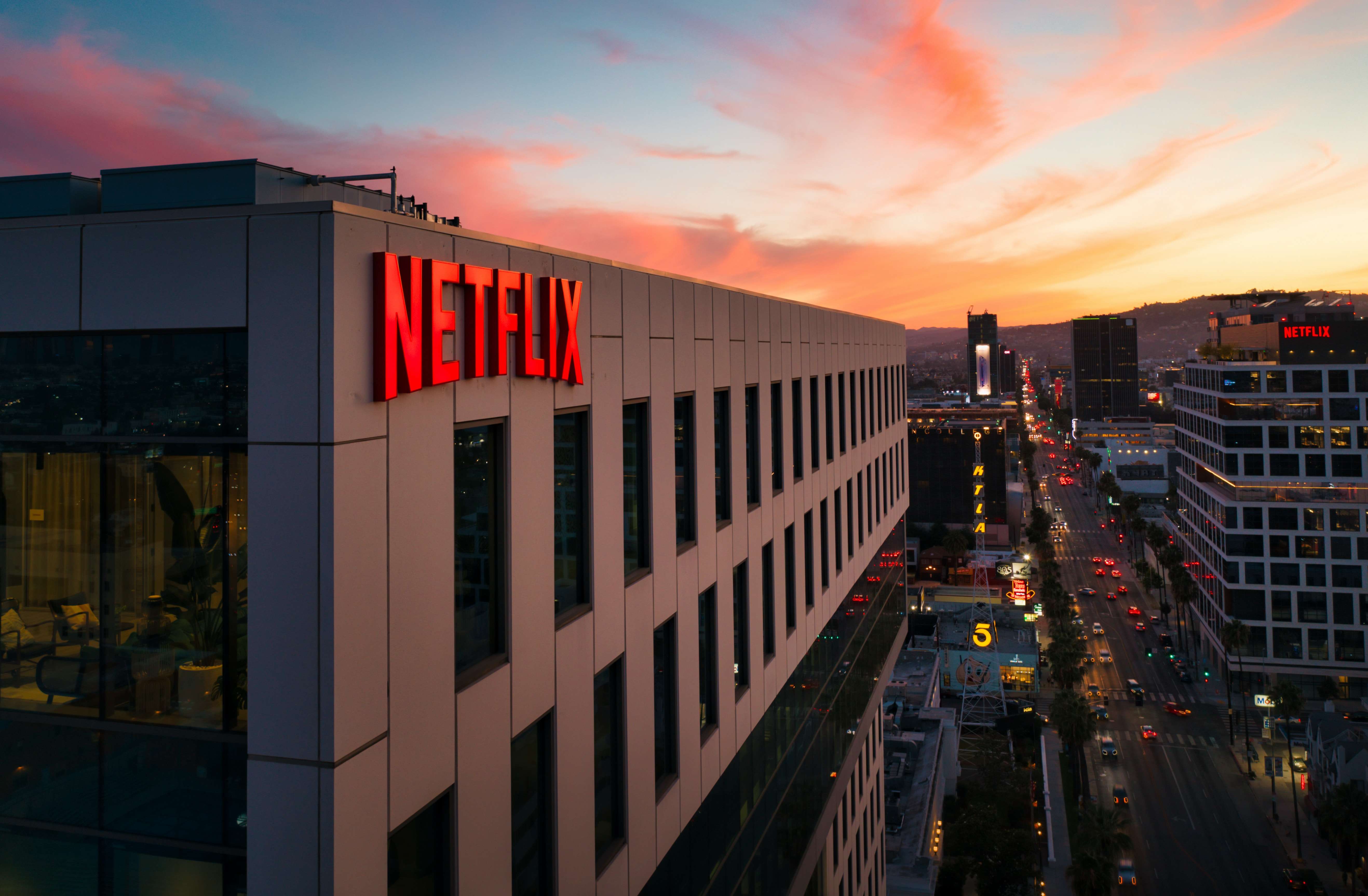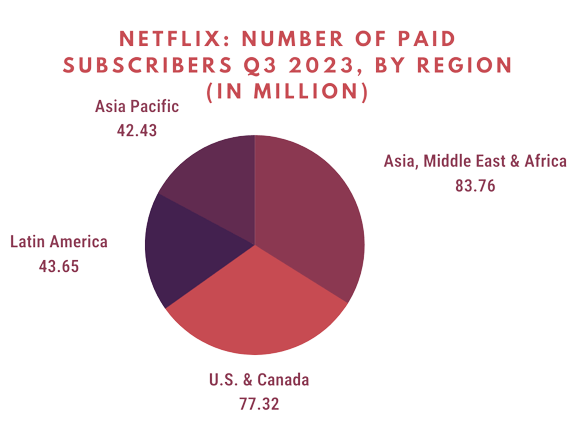- 7 November 2023
- No Comment
- 1485
How Netflix Turned Around Its Business and Became a Streaming Giant

Netflix is one of the most successful and influential companies in the entertainment industry, with over 220 million subscribers worldwide and a market value of over $200 billion.
220 million subscribers worldwide and a market value of over $200 billion.
However, Netflix’s journey to the top was not always smooth and easy. The company faced many challenges and risks along the way and had to constantly adapt and innovate to survive and thrive in the rapidly changing market. In this article, we will explore how Netflix turned around its business and became a streaming giant by looking at four key aspects of its strategy: content, technology, customer satisfaction, and global expansion.
Hello, I’m Nabeel Shaikh—an experienced entrepreneur, investment banker, and chartered accountant—embarking on the insightful journey of Netflix’s business turnaround.
Content: Netflix From DVD Rental to Original Programming
Licensing
Licensing refers to acquiring the rights to stream content from other studios and networks, such as Disney, Warner Bros, NBCUniversal, and others. This allows Netflix to offer a wide variety of content to its subscribers, from classic movies and TV shows to popular franchises and genres. Licensing also helps Netflix enter new markets and regions, where local content is more appealing and relevant to the audience.
Original Programming
Original programming refers to producing its own content, which has given Netflix an edge in the relatively aggressive streaming marketplace and has helped it differentiate itself from different streaming services. Netflix started producing its own original programming in 2013, with House of Cards being its first major hit. Since then, Netflix has created many successful and acclaimed shows and movies, such as Stranger Things, The Crown, Narcos, Orange is the New Black, Roma, The Irishman, and more. Netflix’s original programming has also earned it many awards and nominations, such as Emmys, Oscars, Golden Globes, and others
How much does Netflix spend on content?
Netflix’s content spending is one of the highest among all streaming services. According to Statista, Netflix spent around 16.7 billion U.S. dollars on content in 2022. This marks the second decline so far as compared to the preceding year, which is 17 billion U.S. dollars in content. According to estimates, Netflix’s fees on content material will possibly stabilize at 17 billion U.S. dollars at some stage in the period 2022–2024.
A forecast by Kagan suggests that Netflix could spend around seven billion U.S. dollars on its very own originals in 2023, ranking 5th amongst worldwide media corporations after Disney, Warner Bros., Discovery, Paramount, and Comcast. However, with a percentage of over 25 percent, streaming accounts for the highest quantity of SVOD unique content material spending worldwide.
How does Netflix use facts to create content?
Netflix’s original programming is not only driven by creative vision but also by data analytics. Netflix uses data to track user behavior and preferences, such as what they watch, how long they watch, when they pause or skip, what they rate or review, and more. This enables Netflix to provide personalized recommendations and create content that resonates with its audience. Netflix also uses data to test different aspects of its content, such as titles, thumbnails, trailers, genres, formats, etc., and optimize them for maximum engagement.
Netflix’s Tech Strategy: From Adaptive Streaming to Interactive Content
Netflix’s technology strategy is focused on improving the user experience and delivering high-quality content across different devices and internet speeds. One of the key technologies that Netflix has developed is adaptive streaming, which adjusts the video quality based on the available bandwidth. This guarantees that customers can revel in uninterrupted streaming without buffering or lagging issues. Another technology that Netflix has invested in is interactive content, which allows users to make choices that affect the outcome of the story.
For example, in 2018, Netflix released Black Mirror: Bandersnatch, a movie that lets users decide the fate of the main character by selecting different options on their screens. This technology creates a more immersive and engaging experience for users, as well as a more personalized and diverse content offering. Netflix also uses technology to enhance its content production process.
For instance, Netflix uses artificial intelligence (AI) to assist its writers and directors in creating scripts, dialogues, scenes, etc., based on data insights. Netflix also uses cloud computing to store and process its massive amounts of data and content. Furthermore, Netflix uses encryption and security measures to protect its content from piracy and unauthorized access.
Netflix’s Customer Satisfaction: From No Late Fees to No Ads
No Late Fee Policy
Netflix’s customer satisfaction strategy is based on providing convenience, value, and quality to its subscribers. One of the main features that attracted customers to Netflix in the first place was its no-late fee policy, which eliminated one of the biggest pain points of traditional DVD rental services. Users could keep their DVDs as long as they wanted without worrying about extra charges.
No Ad Policy
Another feature that distinguishes Netflix from other streaming services is its no-ad policy, which means that users can watch their content without any interruptions or distractions. Users can also enjoy unlimited access to Netflix’s entire library of content for a fixed monthly fee, which varies depending on the number of screens and the video resolution they choose. Users can also cancel their subscriptions at any time without any penalties or commitments.
How does Netflix retain its customers?
Netflix also strives to provide high-quality content and service to its customers. As mentioned earlier, Netflix uses data analytics to tailor its content and recommendations to each user’s preferences and tastes. Netflix also provides users with various options and features to enhance their viewing experience, such as subtitles, profiles, downloads, ratings, reviews, etc. Moreover, Netflix maintains a high level of customer service, with 24/7 support, feedback channels, social media engagement, etc.
According to surveys from Whip Media, Netflix has the highest level of satisfaction amongst its users, with 86 percent of the respondents glad with the video carrier provider. This was followed by Disney+, with 77 percent. 14 percent of respondents stated they had been disappointed with BBC TV services. According to research from Antenna, the Netflix churn rate is around 2.4%, exceedingly low in comparison to competitor Hulu’s 4.1%.
This way, Netflix subscribers are much less likely to cancel their subscriptions; that is a full-size feat. Antenna additionally says that Netflix has excessive re-subscription rates, which means that even after clients churn, they’re likely to win them back.
Netflix Global Expansion: From the US to 190 Countries 
The global expansion strategy is based on entering new markets and regions with a localized and customized approach. Netflix launched its streaming service in the US in 2007 and then expanded to Canada in 2010. Since then, Netflix has grown to over 190 countries, covering most of the world except for China, North Korea, Syria, and Crimea.
Netflix’s global expansion is not only driven by market size and potential but also by content availability and demand. Netflix acquires and produces content that is relevant and appealing to each market and region, taking into account the cultural, linguistic, and regulatory differences.
For example, Netflix offers different content libraries in different countries, depending on the licensing agreements and the local preferences. Netflix also produces original content in various languages and genres, such as Money Heist (Spanish), Sacred Games (Hindi), The Witcher (Polish), etc.
How does Netflix partner with local players?
Expansion is also supported by its partnerships and collaborations with local players, such as telecom operators, internet service providers, device manufacturers, content creators, etc.
These partnerships help Netflix reach more customers, reduce costs, increase revenues, and comply with regulations. For example, Netflix has partnered with T-Mobile in the US, Sky in the UK, KDDI in Japan, etc., to offer Netflix as part of their bundles or packages.
What is Netflix’s market share worldwide?
According to Statista, Netflix had a penetration rate of 29 percent worldwide in 2022. This means that nearly one-third of all households with broadband internet access subscribe to Netflix. The penetration rate varied by country, with Norway having the highest at 71 percent, followed by Canada at 61 percent, and the US at 55 percent.
According to Second Measure, Netflix had a market share of 39 percent among the top 5 streaming services worldwide in 2020. This was followed by Amazon Prime Video at 29 percent, Disney+ at 16.8 percent, Hulu at 7.5 percent and HBO at 7.3 percent
Challenges to Netflix
Netflix has been able to overcome many challenges and risks and achieve impressive growth and success. However, Netflix will also face many threats and uncertainties in the future, such as increasing competition, rising costs, changing consumer behavior, regulatory pressures, etc.
Increasing competition
Faces intense competition from other streaming services, such as Disney+, Amazon Prime Video, HBO Max, Hulu, Peacock, Paramount+, Apple TV+, and more. These services offer different content libraries, pricing plans, features, and user experiences, which may attract or retain customers away from Netflix. Some of these services also have the advantage of owning or partnering with major studios, networks, and franchises, which gives them access to exclusive and popular content.
For example, Disney+ has the rights to stream Marvel, Star Wars, Pixar, and National Geographic content, while HBO Max has the rights to stream Warner Bros., DC Comics, HBO, and Cartoon Network content. These services may also invest more in producing their own original content, which may challenge Netflix’s dominance in this area.
Rising costs
Netflix spends a lot of money on acquiring and producing content, as well as on marketing and technology. According to Statista. Netflix spent around 16.7 billion U.S. dollars on content in 2022. This marks the second decline to date compared to the previous year when the video-on-demand service spent over 17 billion U.S. dollars on content.
These costs may increase due to inflation, higher demand for quality content, competition for talent and rights, and regulatory pressures. For example, some countries may require Netflix to pay taxes or fees or to produce or license a certain amount of local content. These costs may affect Netflix’s profitability and cash flow, especially if its revenue growth slows down or declines.
Changing consumer behavior
Netflix relies on its subscribers’ loyalty and satisfaction to retain and grow its customer base. However, consumer behavior may change due to various factors, such as economic conditions, preferences, trends, habits, and alternatives. For example, some consumers may switch to cheaper or free streaming services or use multiple services instead of sticking to one.
Some consumers may also share their passwords with others, which reduces Netflix’s potential revenue. Some consumers may also reduce their streaming time due to other activities or interests. For example, some people may prefer to watch live sports or events, play video games, read books, or go out with friends. These changes may affect Netflix’s subscriber growth and retention rates.
Regulatory pressures due to vast operations in over 190 countries
Exposes it to various laws and regulations that may affect its business. For example, some countries may impose censorship or content restrictions on Netflix’s content, which may limit its creative freedom and appeal. Some countries may also enforce data protection or privacy laws that may require Netflix to comply with certain standards or practices regarding its user data.
Some countries may also impose taxes or fees on Netflix’s revenue or profits, which may reduce its margins. Additionally, some countries may have trade or political disputes with the US or other countries where Netflix operates, which may affect its access or operations in those markets
These are some of the challenges that Netflix may face in the future; therefore, Netflix will have to continue to adapt and innovate to maintain its leadership position and competitive advantage in the streaming industry.
Insights From Nabeel Shaikh
This article has provided a detailed analysis of how Netflix turned around its business and became a streaming giant by focusing on four key aspects of its strategy: content, technology, customer satisfaction, and global expansion. Here are some of the valuable lessons that readers can learn from this article:
The importance of innovation and adaptation
Innovation and adaptation are essential for surviving and thriving in a dynamic and competitive market. Netflix has constantly innovated its content, technology, service, and business model to meet the changing needs and preferences of its customers and the market. Netflix has also adapted to the different challenges and opportunities that it faces along the way, such as competition, costs, consumer behavior, and regulations. By being innovative and adaptive, Netflix has been able to create value and differentiation for itself and its customers.
The power of data and analytics
Data and analytics are powerful tools for creating and delivering high-quality content and services. Netflix has used data and analytics to track user behavior and preferences, provide personalized recommendations, create content that resonates with its audience, test and optimize different aspects of its content, and enhance its content production process. By using data and analytics, Netflix has been able to improve the customer experience and satisfaction, as well as its own efficiency and effectiveness.
The benefits of global expansion
Global expansion is a beneficial strategy for reaching new customers and markets, diversifying revenue sources, and increasing growth potential. Netflix has expanded to over 190 countries, covering most of the world except for China, North Korea, Syria, and Crimea. Netflix has also adopted a localized and customized approach to each market and region, taking into account cultural, linguistic, and regulatory differences. By expanding globally, Netflix has been able to leverage its content and service quality across different markets and regions.
The value of customer satisfaction
Netflix has proven that customer satisfaction is a key factor in retaining and growing its customer base. Netflix has provided convenience, value, and quality to its subscribers by offering features such as no late fees, no ads, unlimited access, flexible cancellation, etc.
Netflix has also strived to provide high-quality content and service to its customers by using data analytics to tailor its content and recommendations to each user’s preferences and tastes, providing various options and features to enhance the viewing experience, maintaining a high level of customer service and support, etc. By satisfying its customers, Netflix has been able to build loyalty and engagement among its subscribers.
Netflix is a remarkable example of a company that has turned around its business and become a streaming giant by focusing on content, technology, customer satisfaction, and global expansion.




